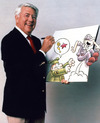
Beetle Bailey made his comic-strip debut as a college cutup in 1950 in a mere 50 newspapers. The feature was soon bought and syndicated by King Features and is noted as the last strip personally approved by William Randolph Hearst.
With America’s entry into the Korean conflict, cartoonist Mort Walker’s star character accidentally enlisted in the Army, and the rest is comic-strip history! Beetle Bailey went on to become the third most widely distributed comic strip of all time. His error proved a blessing in disguise, as readers of more than 1,800 newspapers around the world can attest today.
The strip is rounded off by a melting pot of outrageous characters that have become stars in their own right. In addition, the Beetle Bailey cast of characters have also been the inspiration for dozens of games, toys, puzzles, patches, apparel and greeting cards.
ABOUT THE CREATOR
Mort Walker

Addison Morton Walker was born in El Dorado, Kan., on Sept. 3, 1923, and had cartooning aspirations at a very young age. “If there is such a thing as being born into a profession, it happened to me,” claimed Mort in the introduction to his autobiography. “From my first breath, all I ever wanted to be was a cartoonist.” He drew cartoons for his school newspaper, The Scarritt Scout, when he was ten. He sold his first cartoon to Child Life magazine at the age of 11. His first comic strip, The Limejuicers, ran in the Kansas City Journal when he was 13. He submitted his first comic strip to a national syndicate at the age of 15 and sold magazine cartoons all over the country. By the time Mort graduated from high school, his work was polished and professional.
Mort’s first full-time art job was as a greeting card designer for Hallmark while he attended Kansas City Junior College. In 1942, he was drafted into the Army and served in Italy during the war. He kept an illustrated diary and some of the G.I.s who he met along the way later became inspirations for Beetle Bailey characters. The Army sent him to Washington University in St. Louis where he got an engineering degree. When he returned home, he attended journalism school at the University of Missouri and was editor of the campus humor magazine, the Showme. Although he was eventually kicked out of the journalism school because he hadn’t taken the pre-requisite courses, he graduated with a degree in humanities and is now an honored alumnus of Mizzou.
Mort was working as a magazine cartoonist in New York when John Bailey, the cartoon editor of the Saturday Evening Post, encouraged Mort to do some cartoons based on his college experiences at the University of Missouri. One character, a goof-off with a hat over his eyes named “Spider,” emerged from these efforts. After selling a few college cartoons to the Saturday Evening Post, Mort then decided to submit a comic strip to King Features Syndicate starring Spider and his fraternity brothers. When King bought the strip, Mort changed Spider’s first name to “Beetle” (another King strip, Big Ben Bolt, had a character named Spider) and added “Bailey” in honor of John Bailey.
In addition to Beetle Bailey and Hi and Lois, Mort Walker has been involved in the creation of seven other comic strips. Mrs. Fitz’s Flats (1957 – 1972) was about a little old lady who ran an apartment building and was produced by Mort’s first assistant, Frank Roberge. Sam’s Strip (1961 – 1963) was about a character who managed his own comic strip and was done with Jerry Dumas. Boner’s Ark (1968 – 2000) starred a bumbling sea captain and an ark of animals, and was produced for many years by Frank Johnson. Sam and Silo(1977 – present) is a spin-off of Sam’s Strip set in a small town and is still being done by Jerry Dumas. The Evermores (1982 – 1986) portrayed a family in different historical settings and was done with Johnny Sajem. Betty Boop and Felix (1984 – 1988) combined two classic animation stars and was produced by four of Mort’s sons, Greg, Brian, Morgan and Neal, and Gamin and Patches (1987 – 1988) starring a street urchin and his dog, was done with Bill Janocha and distributed by United Features Syndicate.
Jerry Dumas and three of Mort’s sons, Greg, Brian and Neal, currently assist with the production of Beetle Bailey. Mort and his staff have developed a patented method for delivering daily laughs. Ideas for comic strip “gags” begin with sketchbook drawings and written observations and eventually evolve into the penciled, inked and lettered “originals” which are used to produce the final printed strips. In the endless search for fresh material, the writers occasionally come up with ideas that are unsuitable for American newspapers. Many of these “censored gags” are sent to Sweden to be published. Censorship and size reduction are just two of the creative challenges that cartoonists face on a daily basis.
Mort has served as president of the National Cartoonists Society, vice-president of the Newspaper Features Council, and was the founder of the Museum of Cartoon Art. He has won numerous awards and citations from cartoonist groups and government organizations. He has done special drawings for charities, including the Red Cross, the President’s Committee to Hire the Handicapped and the U.S. Postal Service. He has worked on advertising campaigns for Sprite, FedEx and General Electric. “I’m thankful for the good life cartooning has given me,” Mort says gratefully, “and I try to give back to the profession and the public.”
Today, after more than six decades, Mort Walker is still producing Beetle Bailey, which is the longest tenure of any cartoonist on his original creation in the history of comics.
